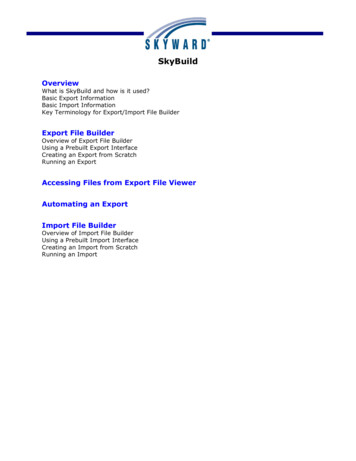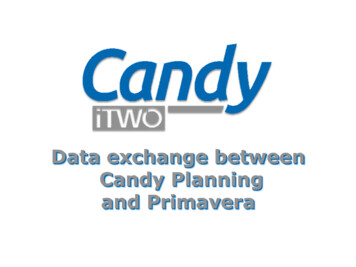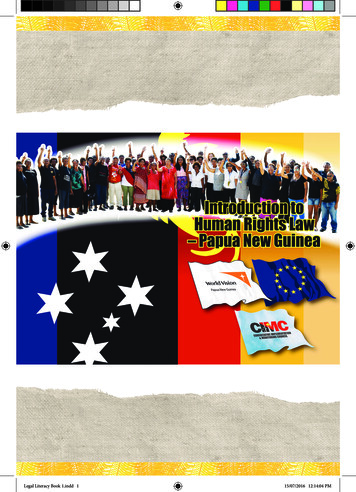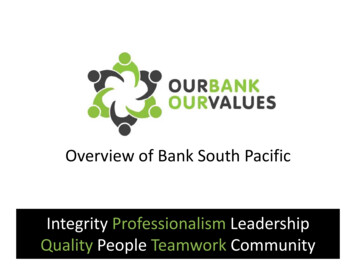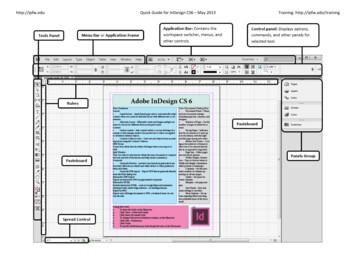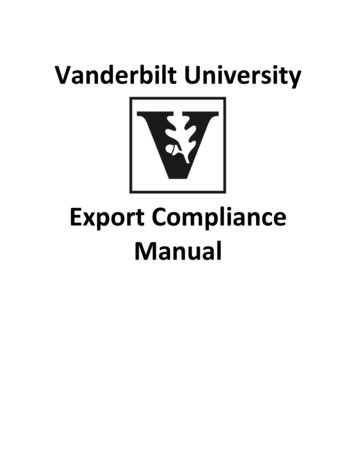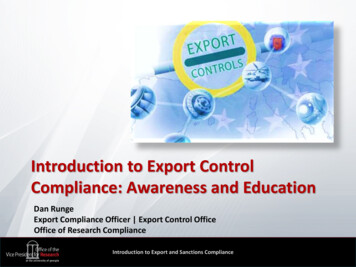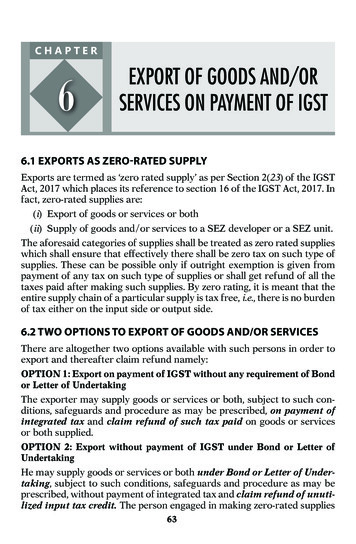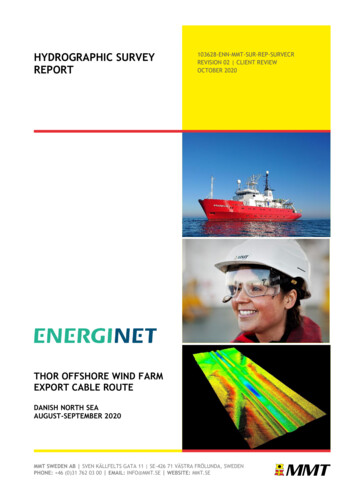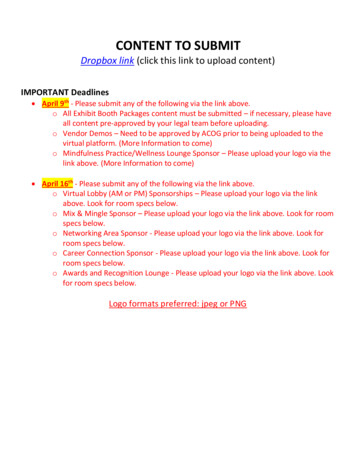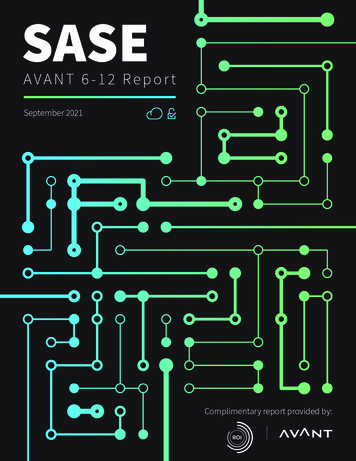
Transcription
Export cover png to conserve RGB colors
AVANT Research & Analytics:The 6-12 ReportEach “6-12 Report” is developed by AVANT Research & Analytics with the assistance of technical teamswithin AVANT. These market research reports are backed by a wealth of data secured by AVANT inour normal course of business, our own primary research of end-customers, and other reputableindustry sources.6-12: CCaaS 6-12: UCaaS 6-12: Security 6-12: SD-WAN State of Disruption ReportOur reports focus on today’s most disruptive technologies, those where the pace of change is rapid.Companies or technologies which – only a few years ago – may have been unknown, are now highlyviable solutions that resolve the business needs that led to their creation. They have disrupted the ITlandscape, a market already well known for its accelerating pace of change and innovation.Every AVANT 6-12 Report gives enterprise technology leaders a contemporary and relevant overviewof the featured subject suitable to making a purchase/non-purchase decision over the next six to 12months. We select each topic based on the potential competitive advantages companies can realizeif they adopt a given solution, depending on their particular industry, market space, or company size.All currency values in this report are expressed in U.S. dollars.Copyright 2021 AVANT Communications, Inc.AVANT SASE 6-12 Report 2
AVANT enables Trusted Advisors (agents, managed service providers, consultants, and specializedchannel partners) to assist with the technology decision-making process through our specializationin disruptive technologies and solutions. We accomplish this with our: Engineering Team of consummate professionals who study the ins-and-outs ofthe latest IT products from the perspective of what best meets the needs of end users. AVANT Assessment Data collected during thousands of customer assessments and decisions. Primary Research collected by surveying customers and Trusted Advisors to inform ourdecision-making process. AVANT PATHFINDER: an IT decision making tool and repository of AVANT’s marketintelligence, empowering comparative searches and intelligent queries. AVANT analysts who conduct original research and analyze data for in-depth insight focusedon, about and for Trusted Advisors, end-customers, and the surrounding ecosystem.We also collect content in conjunction with the Trusted Advisor community, through initialassessment data and various market research tools, including surveys, interviews, focusgroups, and external reports.Copyright 2021 AVANT Communications, Inc.AVANT SASE 6-12 Report 3
Copyright 2021 AVANT Communications, Inc.AVANT SASE 6-12 Report 4
Key Takeaways SASE combines network security functions (such as SWG, CASB, FWaaS, RBI, and ZTNA),with WAN capabilities. “SASE is about building that next generation network for application delivery, which meansit needs to mitigate risk, reduce costs, or increase productivity and profits.” Matt Douglas, CBTS Interpretations of what constitutes SASE vary. Vendors will most likely draw those definitionsbased on the security and networking segments from which they enter the SASE landscape. The SASE market will grow at a compound annual growth rate of 116%, CAGR, attaining amarket value of 5.1 billion by 2024. – Dell’Oro Group In a recent survey of Trusted Advisors conducted by AVANT Research & Analytics, 85% of therespondents were familiar with SASE, and 35% have one or more engagements under way.In 67% of the responses, enhanced security was the customers’ most prominent objective. According to the survey by AVANT Research & Analytics, more than 90% of customers intendto adopt SASE on an incremental basis, as opposed to using a single engagement approach. According to the same survey by AVANT Research & Analytics, 76% of customers turn to TrustedAdvisors to provide educational assistance for SASE.“SASE is a journey; not a destination.- Rich Korn, MasergyCopyright 2021 AVANT Communications, Inc.“AVANT SASE 6-12 Report 5
SASE: The LandscapeSecure Access Service Edge (better known as “SASE,” and pronounced “sassy”) is widely viewed asa critical foundation to providing security in the rapidly expanding environment of cloud computing.Advocates will note that SASE is also an important path towards improving application performance,but AVANT Research & Analytics has learned that the security component is pre-eminent. More thantwo-thirds of the respondents in our survey point to security as the main benefit of SASE.The reasoning is compelling.What once was a relatively straightforward equation of building a virtual moat around the networkperimeter has become infinitely more complicated, given that the notion of the network perimeter,itself, has become obsolete in a borderless cloud-based environment in which almost anything canbe delivered “as a service.”While this phenomenon had been gaining momentum for several years, the Covid-19 pandemicfurther accelerated the trend as work from home was no longer the exception but became thefundamental means of conducting business. Numerous studies show that many employeeshave a strong preference for a work-from-home paradigm, and some are even quitting theircurrent jobs in favor of employers willing to accommodate that preference. Amidst averitable Rubik’s Cube of locations and conditions, effective security becomes moreimportant and more challenging than ever.SASE is a security model, typically cloud-based, whichbundles software-defined networking with networksecurity functions, all of which are delivered by a singleprovider using multiple points-of-presence (POPs) tomaintain high performance on a global basis.SASE combines critical network security functions, such as CASB, RBI, SWG, and ZTNA, with WAN capabilities (e.g.SD-WAN) to deliver secure services and applications at reliable performance levels. Each of these technologieswill be defined and further explored below.As is common with most new(ish) technology concepts, SASE definitions can vary widely as vendors and serviceproviders strive to advance public perceptions that best match their own product/service lines and, by extension,their respective installed bases.Copyright 2021 AVANT Communications, Inc.AVANT SASE 6-12 Report 6
“The goal of SASE is two-fold. Number One:improving application performance; Number Two,improving security. Everything else is marketing,”said Rich Korn, security product specialist atMasergy, a software defined networking servicescompany based in Plano, Texas. “There is somuch marketing out there, it is impossible for thecustomer to truly understand what their optionsare. And that’s why they need the Trusted Advisor.In looking at SASE as a framework, the customers’questions are, what do I need from a connectivitystandpoint, on a site-by-site basis, and what doI need from a security standpoint on a site-bysite basis, taking into consideration each site’sapplication performance requirements, securityrequirements, redundancy requirements, andbudgetary requirements. These will vary fromsite to site, depending on the circumstances.”The transition to SASE is widely recommended tobe done on an incremental basis, as opposed to allat once, with buy-in secured from multiple teamswithin the customer organization. By introducingnew technologies consecutively, as opposed toconcurrently, any glitches are generally easierto identify, locate, and resolve.“It’s a different kind of platform that moves awayfrom the current paradigm of appliance-renderedcapabilities for networking and security,” saidMark Peay, channel director at Cato Networks,an Israeli SASE company that converges SDWAN and network security into a cloud-nativeservice. “Technology needs to be looked at moreholistically; to center the enterprise networkaround the user and identity, as opposed tothe data center.”Copyright 2021 AVANT Communications, Inc.About the AnalystKen Presti develops the strategic frameworkand manages the process of leveragingAVANT’s internal data and external data todrive high-value market research designedto help consultants, agents, channel partners,and other members of the Trusted Advisorcommunity more effectively help theirbusiness customers understand andevaluate Information Technologies (IT).Presti brings a wealth of experience in marketresearch, survey development, focus groupmoderation, interviewing, and contentdevelopment for the technology industry.His primary area of expertise focuses on goto-market and channel strategies spanningnetworking, cloud, security, and telecom.A former Research Director of IDC’s NetworkChannels & Alliances service, he has servedas a Trusted Advisor to several key networkingvendors and service providers. Presti alsohas led his own market research and channeladvisory firm, Presti Research & Consulting,and has worked with other prominent channelconsultancies. Presti specializes in combiningempirical data and his experience partneringwith industry leaders to fully illustratetechnology trends, business model evolution,likely outcomes, and strategies for success.AVANT SASE 6-12 Report 7
Your SASE Data PointsSASE is, in effect a convergence of several networking and security functions into a unified,cloud-native solution designed to enhance application performance and defense against intruders,malware, and other threats. The Dell’Oro Group, a prominent, California-based market research firm,expects the SASE market will grow at a compound annual growth rate of 116%, attaining a marketvalue of 5.1 billion by 2024. Other projections range upwards to 5.4 billion.Looking at the component parts of SASE, researcher MarketsandMarkets says the globalSD-WAN market is likely to grow from 1.9 billion in 2020 to 8.4 billion by 2025The firm expects the global Secure Web Gateway (SWG) market to grow from 4.6 billion in 2019 to 10.9 billion by 2024The cloud access security brokers market size is estimated to grow from 3.34 Billion in 2015 to 7.51 billion by 2020MarketsandMarkets also projects the global Zero Trust security market size to grow from 19.6 billion in 2020 to 51.6 billion by 2026Meanwhile, Firewall as a service, which the firm measured at 0.56 billion in 2017 is expected to reach 1.70 Billion by 2022.Copyright 2021 AVANT Communications, Inc.AVANT SASE 6-12 Report 8
Furthermore, in a public blog post by a prominent analyst, Gartner, Inc. has predicted that 30% ofenterprises will adopt SWG, CASB, ZTNA and branch office firewall as a service (FWaaS) capabilitiesfrom the same vendor by 2024, up from less than 5% in 2020. The firm further predicts that by 2025,at least 60% of enterprises will have explicit strategies and timelines for SASE adoption encompassinguser, branch, and edge access, up from 10% in 2020.In a recent survey of Trusted Advisors conducted by AVANT Research & Analytics, 85% of therespondents were familiar with SASE, and 35% have one or more engagements under way. In 67%of the responses, enhanced security was the customers’ most prominent objective, as shown in thetable below.Copyright 2021 AVANT Communications, Inc.AVANT SASE 6-12 Report 9
As is frequently recommended, most customers intend to adopt SASE on an incremental basis,as opposed to using a single engagement approach, as shown below.Throughout the process, Trusted Advisors will likely factor heavily in SASE migrations, particularly,but not limited to, education for end customers.Top Reasons to Engage Trusted Advisors in SASE DecisionsCopyright 2021 AVANT Communications, Inc.AVANT SASE 6-12 Report 10
Business DriversThe move towards SASE is driven by nothingthat addresses both networking and securityless than the preservation of the company. Iffunctions. This can also offload IT teams fromthat sounds like hyperbole, consider the effectsmenial tasks associated with updates, someof a successful ransomware attack that hasaspects of routine maintenance, and the generallocked down your data. Will you pay, or will youadministration of an on-premises network.not pay? Do you have insurance, and does that“You can no longer have a rational conversationinsurance have the caveats necessary to enableabout security without including the network,the company to deny your claim? Can you restore and you can no longer have a rational discussionfrom backups, or did the attackers gain control of about the network without including security,”those, too?said Rich Korn of Masergy. “They are much too“It’s never happened to us before” is the commontightly integrated. The end customer needsresponse of the unprepared, who often useto look for someone who can combine thosethis fact as a reason to refrain from investing inand add a consultative approach. Everyonesecurity. Yet once an attack has been unleashed,wins when the partner, the customer, and thethis reasoning is rarely seen as satisfactory.technical resources are all on the same pageand targeting the desired outcome.”On a more benign front, SASE customers alsowant solid performance from their applicationsdelivered anywhere in the world throughreliable connectivity and efficient, policy-basedmanagement of an integrated cloud serviceCopyright 2021 AVANT Communications, Inc.In addition, the integration of the network andsecurity silos, combined with the consolidationof point products can favorably impact theexpense line.AVANT SASE 6-12 Report 11
“SASE is about building that next generation network for applicationdelivery, which means it needs to mitigate risk, reduce costs,or increase productivity and profits-Matt Douglas“Senior Director of Solution Engineering CBTS“Compliance is another driver,” added Michael McKinnon, senior vice president of Solutions &Engineering at Globalgig, a network services company based in San Antonio, Texas. “It’s mucheasier to check for compliance when you’re able to offload your security to central location thatcan be scanned. The ability to leverage Zero Trust networking is another driver. That basically tiesinto remote branches and remote users. Trying to develop a Zero Trust network means that if thisdevice is connecting to my network, it’s already authorized. The policies are already applied assoon as it hits the network. This is beneficial to customers because, in the traditional scenario,when a device is going onto that network, you have to go in and program that device to meetcustomer needs. But in this case, all that happens dynamically.”Copyright 2021 AVANT Communications, Inc.AVANT SASE 6-12 Report 12
TechnologyAs described earlier, the mission of SASE is to deliver effective and secure customer outcomes.With that in mind, any effective SASE solution must include the ability to reliably authenticateusers, generally in conjunction with multi-factor authentication (MFA).Here are a few technologies that frequently come into play when building a strategy forSASE migration:SD-WAN stands for software-defined wide area network. It provides a flexible,more redundant network that is less complex to manage than a legacynetwork design.SD-WAN is transport-agnostic, which means that it can unify different typesof connectivity into one cohesive WAN. It also boasts dynamic path selectionmeaning that it can assess the performance of the available network paths,including packet loss, latency, jitter, and congestion, and select the bestavailable path for the circumstances.SD-WAN leverages all available circuits, as opposed to requiring rarely usedbackup networks. By leveraging multiple circuits, SD-WAN provides betterperformance than any one circuit could on its own, allowing businessesto leverage cost-effective Internet circuits to increase efficiency. Doingso often means moving away from legacy hub-and-spoke designs andavoiding network backhaul.“SD-WAN is compatible, but SASE is not a replacement for it,” said Globalgig’sMichael McKinnon. “SASE is about security and remote access. SD-WAN ismore about application routing, policy routing, determining the best pathfor performance, and failover management.”Copyright 2021 AVANT Communications, Inc.AVANT SASE 6-12 Report 13
Technology [cont.]Zero Trust Network Access (ZTNA)Whereas many of the component technologies associated with SASE are wellknown to most IT decision-makers, Zero Trust Network Access stands among themore recent concepts, although these frameworks are not necessarily embeddedin every SASE solution.With ZTNA, every resource is considered to be already compromised, and everyindividual is considered to be a malicious intruder, until proven otherwise. Usersand machines are granted access to specific resources only when necessary andafter identities are verified. ZTNA also isolates on the targeted application asopposed to providing access to servers in general, thereby making it moredifficult for intruders to move laterally through the network, as is typicallythe case when Virtual Private Networks (VPN) are in use.As an example, a user would need permission to access specific files or foldersrequired to do work as opposed to having access to the entire file server. It alsouses security tools, such as multifactor authentication, to validate who has accessto what information. Not only are users required to prove their identities, butdevices are also strategically validated to work with other specific devices.Copyright 2021 AVANT Communications, Inc.AVANT SASE 6-12 Report 14
“ZTNA is completely in its infancy,” said Matt Douglas of CBTS. “ZTNA alsoforces IT shops to take a close look at how they support work-from-homeapplication access. It’s a completely different model.“a specific application as opposed to anenvironment, in which case you can then movelaterally. You can’t move laterally with ZTNA.They are two different methodologies to achievethe same goal of accessing corporate data.“There were people saying a few years ago thatthe VPN client is dead, and that you have to go toZTNA,” Douglas continued. “But that’s not whatwe’re seeing in the marketplace. One of the mainfeatures that customers want in the new SASEplatform is a VPN client. If they’re moving awayfrom the data center, they need cloud security,they’re going to move to SD-WAN with a lot ofInternet connectivity, they’ve got to figure outhow they’re going to get their work from homepeople reliably back, and they are not preparedto make a massive shift to ZTNA. They just wanta VPN client that’s part of their work from homeand SD-WAN fabric. I think you’re going to seeproviders having both a ZTNA option and a VPNoption because there are going to be use casesfor both of them.”“ZTNA can be great in a SASE context, but notas a standalone component,” Korn continued.“You still need to have defense-in-depth withaccess controls, policy controls, and behavioralmonitoring and control. You have to have allthree.”Masergy’s Rich Korn agreed. “VPN in the standardsense provides access to an environment,” hesaid. “ZTNA, as opposed to giving access to anenvironment, gives access only to a specificapplication. Think of it as a much more focusedversion of a VPN. It’s still a virtual private tunnel,but it goes toThe move to ZTNA is seen as a major undertakingthat is not to be taken lightly, especially withinenvironments where IT teams are running at fullthrottle. It can also be a challenge to integrateSASE in organizations where the security teamand networking team are siloed and not ableto work closely together.Copyright 2021 AVANT Communications, Inc.Traffic must also be prioritized so that latencysensitive applications, like Voice over IP (VoIP)and Virtual Desktop Infrastructure (VDI) cantake priority over traffic that is less dependenton speed.AVANT SASE 6-12 Report 15
Firewall as a service (FWaaS) refers to the cloud-based, subscription-baseddelivery of capabilities commonly associated with firewall hardware. Thesecapabilities include access controls, advanced threat prevention, intrusionprevention systems (IPS), DNS security, packet filtering, network monitoring,deep packet inspection, and Internet Protocol security (IPsec), typicallymanaged from a single pane of glass.“The firewall inspects inbound outbound traffic, whereas a secure web gatewayis for the Internet and is literally a proxy, so if anything bad is happening, it’shappening in the gateway before it gets to you,” said Niko O’Hara, seniordirector of Engineering at AVANT. “SWG is an additional layer of internetsecurity on top of having a firewall.”Cloud Access Service Broker (CASB)Cloud access security broker, referred to as “CASB,” is software that allowsbusinesses to safely use the cloud by monitoring user activity and enforcingsecurity policies between users and cloud applications. It is a type of Identityand Access Management technique that is used to regulate who or what canview and use resources in a computing environment. Specific data lossprevention policies can enable the detection of sensitive data in thenetwork and stop that data from being transferred.This capability has become increasingly important as “shadow IT’and the work-from-anywhere” models have gained momentum.Secure Web Gateway (SWG)A secure web gateway, (SWG), enforces policies, supports regulatory compliance,and blocks unwanted and harmful traffic from entering a company’s network.This is accomplished through a combination of malicious website detection(URL filtering), application controls, malware blocking (malicious codedetection), and intrusion detection and prevention.Remote Browser Isolation (RBI)Remote Browser Isolation is a technology that enables the user to access websitesor applications over a separate server that then sends an image of that web pageto the user’s computer without actually accessing the resource from the user’smachine. “You’re looking at an image instead of being on the website, itself,with a local browser,” said AVANT’s Niko O’Hara.Copyright 2021 AVANT Communications, Inc.AVANT SASE 6-12 Report 16
Order of AdoptionSince SASE is something that is generally best implemented over an extended period of time, theorder of adoption for the various SASE-related technologies deserves particular consideration.Start with a thorough review of your circumstances, and then build a strategy based on a three- to fiveyear time horizon leveraging a cross-functional team representing security, networking, compliance,Finance, IT management, and, of course, your Trusted Advisor. The discussions should begin withpreferred business outcomes and then drive downward into more specific details to support users,applications, and remote locations leveraging the cloud and wide area networks. To the extent thatnon-cloud related assets continue to be in use, consider a cloud migration at the soonest practicaltime. Perhaps your list of vendors can be consolidated in order to reduce complexity and costs.These are just a few of the variables worthy of consideration. As the migration continues overtime, conduct ongoing audits to ensure that the desired effects are being achieved.“SASE is a journey; not a destination,” said Masergy’sRich Korn. “Understand what you need to do and thenprioritize and proceed accordingly.”“For some people, SASE will look like it’s just too much, which is one of the reasons you might want tomigrate over a period of time,” said Bill Franklin, senior director of Cloud Engineering at AVANT. “Bringin service providers to run a health or gap assessment and look at it from a posture perspective. Detailyour network, operations, and the security side, which will include SASE components like secure webgateway and identity access management. At this point we just want a lay of the land to helpus understand the gaps and establish priorities.”“The choice of what to prioritize always begins with the question of what’s not working well,” saidCato’s Mark Peay. “What do people complain about? What’s keeping people from being optimallyproductive? What causes end customers pain? Those are the places you want to start. You can evenuse hybrid strategies to resolve pain points without having to re-invent the wheel. That’s how cloudbased services get peppered in and layered.”Copyright 2021 AVANT Communications, Inc.AVANT SASE 6-12 Report 17
“Start by understanding the network itself andidentifying any issues, and cleaning those up,agreed Globalgig’s McKinnon. “Regardless ofwhich technologies you’d like to add, if youhave underlying issues, they’re not magicallygoing to be fixed. So, I would apply SASE after Ideal with the network architecture issues. Theonly exception would be if you had some kindof compliance requirement that needed to beaddressed immediately. I don’t see any problemwith deploying SASE ahead of that. But typically,if you apply SASE while you have an underlyingnetwork issue, you’re only complicating mattersbecause now you have multiple new componentsand you have to determine what’s causingthe problem.”Once priorities are established, the methodologyfor migration pretty much writes itself.Another complicating factor may be a managerialreluctance to take a stand in favor of SASEmigration or, at the other end of the spectrum,a situation in which you have “too many cooksin the kitchen.” In the first case, the CIO or otherexecutives may need to clearly articulate thedirection and assign team members to takedirect action. In other situations, networkingpeople, security staff, and others may beginjockeying for budgetary position, in which casethe resulting strategy may become less coherent.In extreme cases, you may see multiple toolsserving the same function because a clearstrategy was not in place.“The network and security teams sometimes don’t likeeach other,” added AVANT’s Bill Franklin. “Some teamshave been stepping on each other’s toes for years, inwhich case you need to start at a place where bothsides can agree.”“Some individuals may be more cloud-focused than others who are more appliance-based – whichmeans you may be displacing vendors with whom they’ve been working for a long time, and thatcould cause friction.”In such cases it’s not just a technical decision; it’s a political decision as well.Copyright 2021 AVANT Communications, Inc.AVANT SASE 6-12 Report 18
Choosing Your SolutionIn addition to SD-WAN, ZTNA, CASB, SWG, RBI, and FWaaS, there is a number of other capabilitiesthat should also be considered when choosing your SASE path. These would include DNS protection,sandboxing, and API/application protection. Your Trusted Advisor will be instrumental in helping youto assess the full range of options, including what should be done, and in what order they shouldbe executed.As you map out your journey, it might become clear thatyou need fewer technology vendors than you have inthe past. If such a move is feasible, this can potentiallyreduce costs and almost always results in streamlinedmanagement procedures and improved visibility into thefunctions of the network and its security components.In some cases, you can go from 10 vendors to perhaps two or three. Getting down to a singlevendor is often impossible given that there are very few vendors, if any, that will be able tomeet every requirement.You may have different options from different vendors that can be bundled together by the same SASEprovider. These decisions should be prominent in your solution selection process, and your TrustedAdvisor can be instrumental in helping you to make the right choices.“If you buy an SD-WAN product from one company and then a next generation firewall and secure webgateway from another, and CASB from someone else, it creates a hodge-podge of vendors that youhave to manage,” said Peay of Cato. “In some cases, it also drags down performance for the user.Large enterprises often have fiefdoms in which they use certain products because they like them,but we end up with a hodge-podge. It helps to work with the C-suite as much as possible.”Copyright 2021 AVANT Communications, Inc.AVANT SASE 6-12 Report 19
“One theory is that one provider buildseverything together with the idea that this willbe easier,” said Rich Korn of Masergy. “Theother option is best-of-breed. You want thesimplest design that does not degrade yourapplication performance and your securityrequirements.”Top Questions to Ask Your TrustedAdvisor How should we design a SASE roadmap?“Our position favors ‘best of breed,’ but you’dbetter have a managed services overlay,”countered Matt Douglas. “So, our approachto date has been using best of breed butdelivering it in a bundled fashion, out of thesame project management teams, the samesupport teams, the same deployment teams.You’ve got to deliver a best-of-breed solutionthat feels like a bundle and can be supportedlike a bundle.” How does SASE work, compared to mycurrent technology?Meanwhile, bear in mind that, for theforeseeable future, interpretations of whatconstitutes SASE will likely be widely variable.Vendors will most likely draw those definitionsbased on the security and networkingsegments from which they enter the SASElandscape. For example, some are morefocused on cloud-native offerings while othersare more driven by appliances in the customerpremises. Such variations in approach arecommon to new technologies, but it alsorequires end customers to be diligent indeveloping a vision for their desired end state.Doing so will go a long way towards ensuringthat expenditures are properly aligned. How can SASE reduce my need forsecurity-related apps and MSP services?“You’ll also want to understand the ecosystems,”added McKinnon. “As you consider differentoptions, it’s important to know exactly whatthe product offerings are. Some have acquiredcompanies and have not fully integrated it,whereas others have done a really good jobof this.”Copyright 2021 AVANT Communications, Inc. Will SASE replace MPLS, VPNs, SD-WAN,or similar technologies? Help me quantify the business value. How will SASE impact the ability
3.34 Billion in 2015 to 7.51 billion by 2020 MarketsandMarkets also projects the global Zero Trust security market size to grow from 19.6 billion in 2020 to 51.6 billion by 2026 Meanwhile, Firewall as a service, which the firm measured at 0.56 billion in 2017 is expected to reach 1.70 Billion by 2022.
